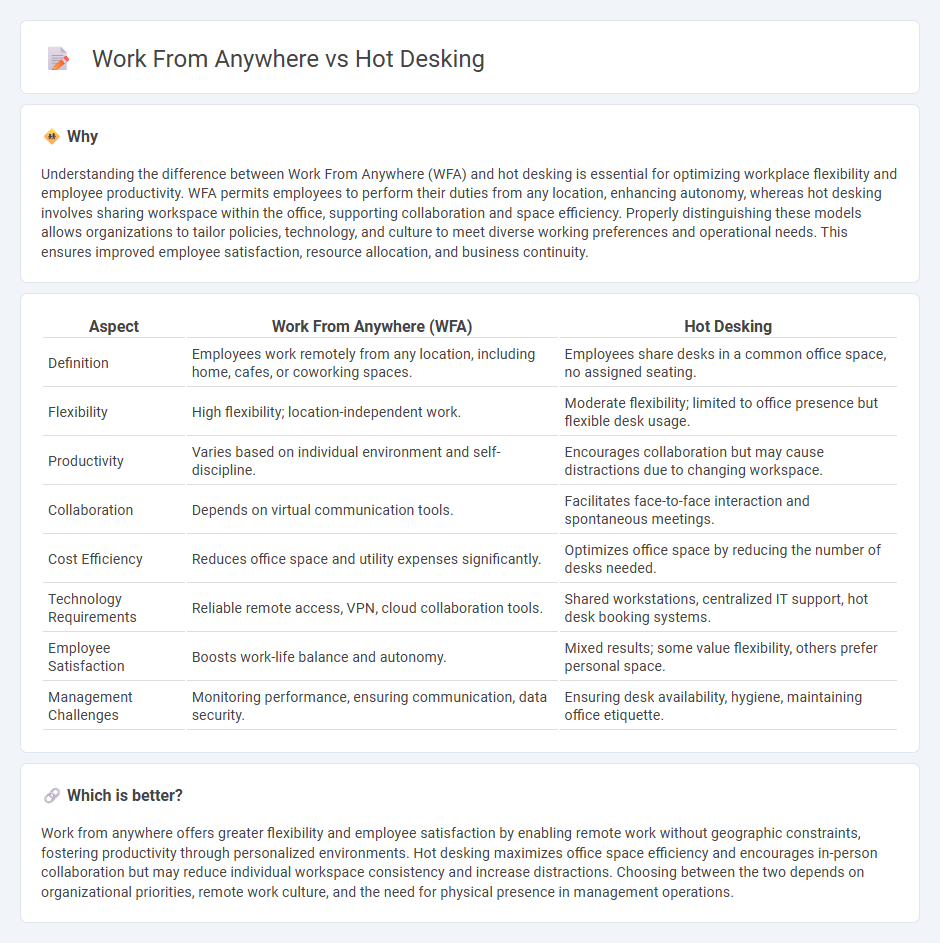
Work from anywhere empowers employees with flexibility and autonomy, enhancing productivity and job satisfaction through location independence. Hot desking maximizes office space efficiency by allowing shared use of desks, fostering collaboration but sometimes causing lack of personal workspace. Explore deeper insights to determine which management approach best suits your organizational goals.
Why it is important
Understanding the difference between Work From Anywhere (WFA) and hot desking is essential for optimizing workplace flexibility and employee productivity. WFA permits employees to perform their duties from any location, enhancing autonomy, whereas hot desking involves sharing workspace within the office, supporting collaboration and space efficiency. Properly distinguishing these models allows organizations to tailor policies, technology, and culture to meet diverse working preferences and operational needs. This ensures improved employee satisfaction, resource allocation, and business continuity.
Comparison Table
| Aspect | Work From Anywhere (WFA) | Hot Desking |
|---|---|---|
| Definition | Employees work remotely from any location, including home, cafes, or coworking spaces. | Employees share desks in a common office space, no assigned seating. |
| Flexibility | High flexibility; location-independent work. | Moderate flexibility; limited to office presence but flexible desk usage. |
| Productivity | Varies based on individual environment and self-discipline. | Encourages collaboration but may cause distractions due to changing workspace. |
| Collaboration | Depends on virtual communication tools. | Facilitates face-to-face interaction and spontaneous meetings. |
| Cost Efficiency | Reduces office space and utility expenses significantly. | Optimizes office space by reducing the number of desks needed. |
| Technology Requirements | Reliable remote access, VPN, cloud collaboration tools. | Shared workstations, centralized IT support, hot desk booking systems. |
| Employee Satisfaction | Boosts work-life balance and autonomy. | Mixed results; some value flexibility, others prefer personal space. |
| Management Challenges | Monitoring performance, ensuring communication, data security. | Ensuring desk availability, hygiene, maintaining office etiquette. |
Which is better?
Work from anywhere offers greater flexibility and employee satisfaction by enabling remote work without geographic constraints, fostering productivity through personalized environments. Hot desking maximizes office space efficiency and encourages in-person collaboration but may reduce individual workspace consistency and increase distractions. Choosing between the two depends on organizational priorities, remote work culture, and the need for physical presence in management operations.
Connection
Work from anywhere (WFA) policies increase the demand for flexible office solutions like hot desking, allowing employees to occupy any available workspace instead of assigned desks. Hot desking optimizes office space utilization and supports dynamic team collaboration in hybrid work environments facilitated by WFA. Both concepts drive organizational agility, reduce real estate costs, and enhance employee productivity by accommodating diverse work locations and schedules.
Key Terms
Flexibility
Hot desking offers flexibility by allowing employees to choose any available workspace within the office, promoting collaboration and efficient use of office resources. Work from anywhere extends flexibility further by enabling employees to perform tasks remotely from any location, thus supporting diverse work-life balance preferences and reducing commute times. Explore how these flexible work models can enhance productivity and employee satisfaction.
Space Utilization
Hot desking maximizes office space utilization by allowing multiple employees to share a limited number of desks on a rotating basis, reducing unused workstations and lowering real estate costs. Work from anywhere emphasizes flexibility by enabling employees to work remotely or from various locations, which can lead to decreased on-site office density and potentially underutilized physical spaces. Explore how these strategies impact your organization's space efficiency and operational agility.
Employee Autonomy
Hot desking offers employees flexibility by allowing them to choose different workstations within the office, promoting dynamic collaboration and space efficiency. Work from anywhere (WFA) empowers employees with the highest level of autonomy, enabling them to work from any location, which enhances work-life balance and job satisfaction. Explore the benefits and challenges of both approaches to determine the best fit for employee autonomy in your organization.
Source and External Links
Hot Desking - Wikipedia - Hot desking is a workplace system where desks are shared by different workers, optimizing space and reducing costs.
Hot Desking in a Flexible Workspace - OfficeSpace - Hot desking is a flexible strategy that enhances collaboration and employee flexibility by optimizing space utilization.
What is hot-desking and what are the benefits? - WeWork - Hot desking allows desks to be used on an ad hoc basis, promoting flexibility and community in both private offices and coworking spaces.
 dowidth.com
dowidth.com